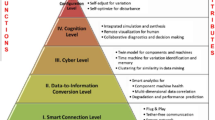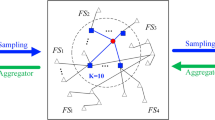Abstract
This paper proposes a novel data preprocessing method that converts numeric data into representative graphs (polygons) expressing all of the relationships between data variables in a systematic way based on Hamiltonian cycles. The advantage of the proposed method is that it has an embedded feature extraction capability in which each generated polygon depicts a class-specific representation in the data, thereby supporting accurate “end-to-end learning” in industrial fault classification applications. Moreover, the generated polygons can play a significant role in the interpretation of trained deep learning fault classifiers. The performance of the proposed method was demonstrated using a benchmark dataset in the process industry. It was also tested successfully to classify challenging faults in major equipment in a thermomechanical pulp mill located in Canada. The results of the proposed method show better performance than other comparable fault classifiers.








Similar content being viewed by others
References
Afrasiabi, S., Afrasiabi, M., Parang, B., Mohammadi, M., Arefi, M. M., & Rastegar, M. (2019). Wind Turbine Fault Diagnosis with Generative-Temporal Convolutional Neural Network. 2019 IEEE International Conference on Environment and Electrical Engineering and 2019 IEEE Industrial and Commercial Power Systems Europe (EEEIC/I&CPS Europe), pp. 1–5.
Ayubi Rad, M. A., & Yazdanpanah, M. J. (2015). Designing supervised local neural network classifiers based on EM clustering for fault diagnosis of Tennessee Eastman process. Chemometrics and Intelligent Laboratory Systems, 146, 149–157. https://doi.org/10.1016/j.chemolab.2015.05.013.
Bache, K., & Lichman, M. (2013). UCI machine learning repository.
Bajpai, P. (2018). Brief Description of the Pulp and Papermaking Process. In Biotechnology for pulp and paper processing (pp. 9–26). Springer.
Bathelt, A., Ricker, N. L., & Jelali, M. (2015). Revision of the tennessee eastman process model. IFAC-PapersOnLine, 48(8), 309–314.
Chen, X., Zhang, B., & Gao, D. (2020). Bearing fault diagnosis base on multi-scale CNN and LSTM model. Journal of Intelligent Manufacturing, (December 2019). https://doi.org/10.1007/s10845-020-01600-2
Chen, Z., Zeng, X., Li, W., & Liao, G. (2016). Machine fault classification using deep belief network. Conference Record - IEEE Instrumentation and Measurement Technology Conference, 2016-July(51475170). https://doi.org/10.1109/I2MTC.2016.7520473
Choi, H., Lee, H., & Kim, H. (2009). Fast detection and visualization of network attacks on parallel coordinates. Computers & Security, 28(5), 276–288.
Chollet, F. (2018). Keras: The python deep learning library. Astrophysics Source Code Library, ascl-1806. URL (available February 11, 2021): https://github.com/keras-team/keras
D’Angelo, M. F. S. V., Palhares, R. M., Camargos Filho, M. C. O., Maia, R. D., Mendes, J. B., & Ekel, P. Y. (2016). A new fault classification approach applied to Tennessee Eastman benchmark process. Applied Soft Computing, 49, 676–686. https://doi.org/10.1016/j.asoc.2016.08.040.
Downs, J. J., & Vogel, E. F. (1993). A plant-wide industrial process control problem. Computers & Chemical Engineering, 17(3), 245–255.
Dunia, R., Edgar, T. F., & Nixon, M. (2013). Process monitoring using principal components in parallel coordinates. AIChE Journal, 59(2), 445–456.
Duvall, P. M., & Riggs, J. B. (2000). On-line optimization of the Tennessee Eastman challenge problem. Journal of Process Control, 10(1), 19–33. https://doi.org/10.1016/S0959-1524(99)00041-4.
Elizabeth Bush Nathan Gillett, E. W. J. F.,et al. (2019). Canada’s Changing Climate Report. Retrieved from https://changingclimate.ca/CCCR2019/
Eren, L., Ince, T., & Kiranyaz, S. (2019). A generic intelligent bearing fault diagnosis system using compact adaptive 1D CNN classifier. Journal of Signal Processing Systems, 91(2), 179–189.
Gecgel, O., Ekwaro-Osire, S., Dias, J. P., Serwadda, A., Alemayehu, F. M., & Nispel, A. (2019). Gearbox Fault Diagnostics Using Deep Learning with Simulated Data. Proceedings of the 2019 IEEE International Conference on Prognostics and Health Management, pp. 1–8.
Golshan, M., Boozarjomehry, R. B., & Pishvaie, M. R. (2005). A new approach to real time optimization of the Tennessee Eastman challenge problem. Chemical Engineering Journal, 112(1), 33–44. https://doi.org/10.1016/j.cej.2005.06.005.
Gunerkar, R. S., Jalan, A. K., & Belgamwar, S. U. (2019). Fault diagnosis of rolling element bearing based on artificial neural network. Journal of Mechanical Science and Technology, 33(2), 505–511. https://doi.org/10.1007/s12206-019-0103-x.
Hasan, M. J., Sohaib, M., & Kim, J.-M. (2019). 1D CNN-Based Transfer Learning Model for Bearing Fault Diagnosis Under Variable Working Conditions. In S. Omar, W. S. Haji Suhaili, & S. Phon-Amnuaisuk (Eds.), Computational Intelligence in Information Systems (pp. 13–23). Cham: Springer International Publishing.
Hauser, H., Ledermann, F., & Doleisch, H. (2002). Angular brushing of extended parallel coordinates. IEEE Symposium on Information Visualization, 2002. INFOVIS, 2002, 127–130.
Heo, S., & Lee, J. H. (2018). Fault detection and classification using artificial neural networks. IFAC-PapersOnLine, 51(18), 470–475.
Hsu, C. Y., & Liu, W. C. (2020). Multiple time-series convolutional neural network for fault detection and diagnosis and empirical study in semiconductor manufacturing. Journal of Intelligent Manufacturing, (0123456789). https://doi.org/10.1007/s10845-020-01591-0
Hurley, C. B., & Oldford, R. W. (2010). Pairwise display of high-dimensional information via eulerian tours and hamiltonian decompositions. Journal of Computational and Graphical Statistics, 19(4), 861–886.
Ian Goodfellow Yoshua Bengio, A. C. (2017). The Deep Learning Book. MIT Press, 521(7553), 785 https://doi.org/10.1016/B978-0-12-391420-0.09987-X
Inselberg, A. (2009). Parallel coordinates. Berlin: Springer.
Inselberg, A., & Dimsdale, B. (1990). Parallel coordinates: a tool for visualizing multi-dimensional geometry. Proceedings of the 1st Conference on Visualization’90, 361–378.
Jing, C., & Hou, J. (2015). SVM and PCA based fault classification approaches for complicated industrial process. Neurocomputing, 167, 636–642. https://doi.org/10.1016/j.neucom.2015.03.082.
King, R. D., Feng, C., & Sutherland, A. (1995). Statlog: comparison of classification algorithms on large real-world problems. Applied Artificial Intelligence an International Journal, 9(3), 289–333.
Larsson, T., Hestetun, K., Hovland, E., & Skogestad, S. (2001). Self-optimizing control of a large-scale plant: The Tennessee Eastman process. Industrial & Engineering Chemistry Research, 40(22), 4889–4901.
Larsson, T., & Skogestad, S. (2000). Plantwide control-A review and a new design procedure.
LeCun, Y., Bengio, Y., & Hinton, G. (2015). Deep learning. Nature, 521(7553), 436.
Lee, D., Siu, V., Cruz, R., & Yetman, C. (2016). Convolutional Neural Net and Bearing Fault Analysis. International Conference Data Mining, 194–200. https://pdfs.semanticscholar.org/6e45/f39b1e50cfd10deaabd1d786f
Lee, K. B., Cheon, S., & Kim, C. O. (2017). A convolutional neural network for fault classification and diagnosis in semiconductor manufacturing processes. IEEE Transactions on Semiconductor Manufacturing, 30(2), 135–142. https://doi.org/10.1109/TSM.2017.2676245.
Li, X., Zhang, W., Ding, Q., & Sun, J. Q. (2020a). Intelligent rotating machinery fault diagnosis based on deep learning using data augmentation. Journal of Intelligent Manufacturing, 31(2), 433–452. https://doi.org/10.1007/s10845-018-1456-1.
Li, Z., Wang, Y., & Wang, K. (2020b). A data-driven method based on deep belief networks for backlash error prediction in machining centers. Journal of Intelligent Manufacturing, 31(7), 1693–1705. https://doi.org/10.1007/s10845-017-1380-9.
Lipton, Z. C., Elkan, C., & Naryanaswamy, B. (2014). Optimal thresholding of classifiers to maximize F1 measure. Joint European Conference on Machine Learning and Knowledge Discovery in Databases, pp. 225–239.
Lv, F., Wen, C., Bao, Z., & Liu, M. (2016). Fault diagnosis based on deep learning. Proceedings of the American Control Conference, 2016-July(2), pp. 6851–6856. https://doi.org/10.1109/ACC.2016.7526751
McAvoy, T. J., & Ye, N. (1994). Base control for the Tennessee Eastman problem. Computers & Chemical Engineering, 18(5), 383–413.
NRCan, N. R. C. (2015). Improving Process Operation Using the Power of Advanced Data Analysis.
Om, H., & Kundu, A. (2012). A hybrid system for reducing the false alarm rate of anomaly intrusion detection system. 2012 1st International Conference on Recent Advances in Information Technology (RAIT), pp. 131–136.
Peng, D., Liu, Z., Wang, H., Qin, Y., & Jia, L. (2019). A novel deeper one-dimensional CNN with residual learning for fault diagnosis of wheelset bearings in high-speed trains. IEEE Access, 7, 10278–12093. https://doi.org/10.1109/ACCESS.2018.2888842.
Qi, X., Yuan, Z., & Han, X. (2015). Diagnosis of misalignment faults by tacholess order tracking analysis and RBF networks. Neurocomputing, 169, 439–448. https://doi.org/10.1016/j.neucom.2014.09.088.
Ragab, A., El-Koujok, M., Poulin, B., Amazouz, M., & Yacout, S. (2018). Fault diagnosis in industrial chemical processes using interpretable patterns based on Logical Analysis of Data. Expert Systems with Applications, 95, 368–383. https://doi.org/10.1016/j.eswa.2017.11.045.
Ragab, A., Koujok, M. E., Ghezzaz, H., Amazouz, M., Ouali, M.-S., & Yacout, S. (2019a). Deep understanding in industrial processes by complementing human expertise with interpretable patterns of machine learning. Expert Systems with Applications, 122, 388–405. https://doi.org/10.1016/j.eswa.2019.01.011.
Ragab, A., Yacout, S., Ouali, M. S., & Osman, H. (2019b). Prognostics of multiple failure modes in rotating machinery using a pattern-based classifier and cumulative incidence functions. Journal of Intelligent Manufacturing, 30(1), 255–274. https://doi.org/10.1007/s10845-016-1244-8.
Ricker, N. L. (1996). Decentralized control of the Tennessee Eastman challenge process. Journal of Process Control, 6(4), 205–221.
Rolnick, D., Donti, P. L., Kaack, L. H., Kochanski, K., Lacoste, A., Sankaran, K., et al. (2019). Tackling climate change with machine learning. ArXiv Preprint arXiv:1906.05433.
Sanderson, C., & Gruen, R. (2006). Analytical models for decision-making. UK: McGraw-Hill Education.
Santamaria, R., Therón, R., & Quintales, L. (2008). A visual analytics approach for understanding biclustering results from microarray data. BMC Bioinformatics, 9(1), 247.
Shao, S. Y., Sun, W. J., Yan, R. Q., Wang, P., & Gao, R. X. (2017). A Deep Learning Approach for Fault Diagnosis of Induction Motors in Manufacturing. Chinese Journal of Mechanical Engineering (English Edition), 30(6), 1347–1356. https://doi.org/10.1007/s10033-017-0189-y.
Siirtola, H., & Räihä, K.-J. (2006). Interacting with parallel coordinates. Interacting with Computers, 18(6), 1278–1309.
Simonyan, K., & Zisserman, A. (2014). Very deep convolutional networks for large-scale image recognition. ArXiv Preprint ArXiv:1409.1556.
Talbot, D., & Boiral, O. (2013). Can we trust corporates GHG inventories? An investigation among Canada’s large final emitters. Energy Policy, 63, 1075–1085.
Telea, A. C. (2007). Data Visualization: Principles and practice. In Data Visualization: Principles and Practice. https://doi.org/10.1201/b10679
Tian, J., Morillo, C., Azarian, M. H., & Pecht, M. (2016). Motor Bearing Fault Detection Using Spectral Kurtosis-Based Feature Extraction Coupled With K-Nearest Neighbor Distance Analysis. IEEE Transactions on Industrial Electronics, 63(3), 1793–1803. https://doi.org/10.1109/TIE.2015.2509913.
Tidriri, K., Chatti, N., Verron, S., & Tiplica, T. (2016). Bridging data-driven and model-based approaches for process fault diagnosis and health monitoring: A review of researches and future challenges. Annual Reviews in Control, 42, 63–81.
Wang, Y., Zhou, J., Zheng, L., & Gogu, C. (2020). An end-to-end fault diagnostics method based on convolutional neural network for rotating machinery with multiple case studies. Journal of Intelligent Manufacturing. https://doi.org/10.1007/s10845-020-01671-1
Wegman, E. J. (1990). Hyperdimensional data analysis using parallel coordinates. Journal of the American Statistical Association, 85(411), 664–675.
Wilke, C. O. (2019). Fundamentals of data visualization: a primer on making informative and compelling figures. O'Reilly Media.
Wong, P. C., & Bergeron, R. D. (1996). Multiresolution multidimensional wavelet brushing. Proceedings of Seventh Annual IEEE Visualization’96, 141–148.
Wu, H., & Zhao, J. (2018). Deep convolutional neural network model based chemical process fault diagnosis. Computers and Chemical Engineering, 115, 185–197. https://doi.org/10.1016/j.compchemeng.2018.04.009.
Yin, S., Ding, S. X., Haghani, A., Hao, H., & Zhang, P. (2012). A comparison study of basic data-driven fault diagnosis and process monitoring methods on the benchmark Tennessee Eastman process. Journal of Process Control, 22(9), 1567–1581. https://doi.org/10.1016/j.jprocont.2012.06.009.
Zhang, Q., Gao, J., Dong, H., & Mao, Y. (2018). WPD and DE/BBO-RBFNN for solution of rolling bearing fault diagnosis. Neurocomputing, 312, 27–33. https://doi.org/10.1016/j.neucom.2018.05.014.
Zhang, S., Zhang, S., Wang, B., & Habetler, T. G. (2019). Machine learning and deep learning algorithms for bearing fault diagnostics-a comprehensive review. ArXiv Preprint ArXiv:1901.08247.
Zhang, Z., & Zhao, J. (2017). A deep belief network based fault diagnosis model for complex chemical processes. Computers and Chemical Engineering, 107, 395–407. https://doi.org/10.1016/j.compchemeng.2017.02.041.
Zhou, W., Li, X., Yi, J., & He, H. (2019). A Novel UKF-RBF Method Based on Adaptive Noise Factor for Fault Diagnosis in Pumping Unit. IEEE Transactions on Industrial Informatics, 15(3), 1415–1424. https://doi.org/10.1109/TII.2018.2839062.
Acknowledgements
This work was supported by Natural Resources Canada’s OERD (Office for Energy Research and Development) program.
Author information
Authors and Affiliations
Corresponding author
Additional information
Publisher's Note
Springer Nature remains neutral with regard to jurisdictional claims in published maps and institutional affiliations.
Rights and permissions
About this article
Cite this article
Elhefnawy, M., Ragab, A. & Ouali, MS. Fault classification in the process industry using polygon generation and deep learning. J Intell Manuf 33, 1531–1544 (2022). https://doi.org/10.1007/s10845-021-01742-x
Received:
Accepted:
Published:
Issue Date:
DOI: https://doi.org/10.1007/s10845-021-01742-x




